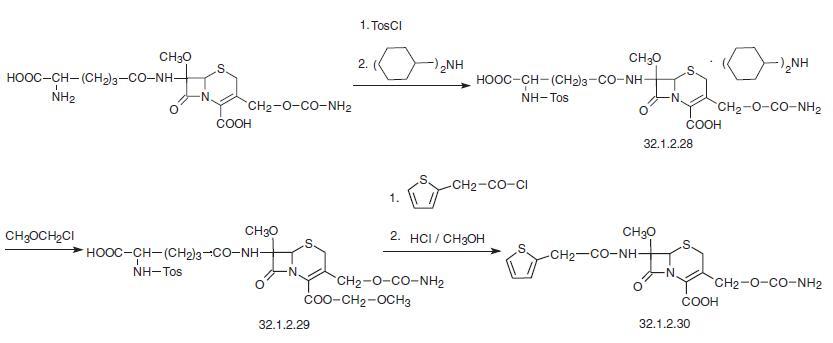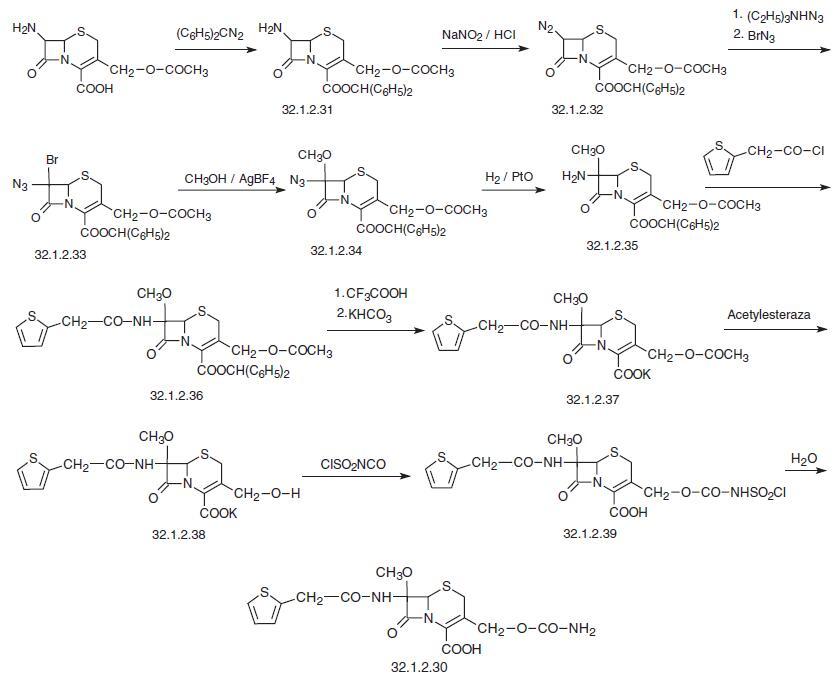| Identification | More | [Name]
Cefoxitin | [CAS]
35607-66-0 | [Synonyms]
CEFOXITIN
(6r-cis)-ethyl)-7-methoxy-8-oxo-7-((2-thienylacetyl)amino)
cephoxitin
cfx
CEFOXITIN ACID
5-Thia-1-azabicyclo[4.2.0]oct-2-ene-2-carboxylic acid, 3-[[(aminocarbonyl)oxy]methyl]-7-methoxy-8-oxo-7-[(2-thienylacetyl)amino]-, (6R,7S)-
5-Thia-1-azabicyclo[4.2.0]oct-2-ene-2-carboxylic acid, 3-[[(aminocarbonyl)oxy]methyl]-7-methoxy-8-oxo-7-[(2-thienylacetyl)amino]-, (6R-cis)-
(6R-cis)-3-[(Carbamoyloxy)methyl]-7-methoxy-8-oxo-7-(2-thienylacetamido)-5-thia-1-azabicyclo[4.2.0]oct-2-ene-2-carboxylic acid
Mefoxin
5-Thia-1-azabicyclo[4.2.0]oct-2-ene-2-carboxylic acid, 3-[[(aminocarbonyl)oxy]methyl]-7-methoxy-8-oxo-7-[[2-(2-thienyl)acetyl]amino]-, (6R,7S)-
Rephoxitin
(6R,7S)-3-(Carbamoyloxymethyl)-7β-methoxy-8-oxo-7-[(2-thienyl)acetylamino]-5-thia-1-azabicyclo[4.2.0]oct-2-ene-2-carboxylic acid | [EINECS(EC#)]
252-641-2 | [Molecular Formula]
C16H17N3O7S2 | [MDL Number]
MFCD00072014 | [Molecular Weight]
427.45 | [MOL File]
35607-66-0.mol |
| Chemical Properties | Back Directory | [Melting point ]
149-150℃ | [Boiling point ]
843℃ | [density ]
1.4441 (rough estimate) | [refractive index ]
1.6390 (estimate) | [RTECS ]
XI0386500 | [Fp ]
>110°(230°F) | [storage temp. ]
Sealed in dry,2-8°C | [solubility ]
DMSO (Slightly), Methanol (Slightly) | [form ]
Solid | [pka]
2.2(at 25℃) | [color ]
White to Off-White | [Water Solubility ]
Predicted solubility in water is less than 0.2mg/ml | [CAS DataBase Reference]
35607-66-0(CAS DataBase Reference) | [EPA Substance Registry System]
35607-66-0(EPA Substance) |
| Hazard Information | Back Directory | [Description]
Cefoxitin contains the same C-7 side chain as cephalothin and the same C-3 side chain as cefuroxime. The
most novel chemical feature of cefoxitin is the possession of an α-oriented methoxyl group in place of the
normal H-atom at C-7. This increased steric bulk conveys very significant stability against β-lactamases. The
inspiration for these functional groups was provided by the discovery of the naturally occurring antibiotic
cephamycin C
derived from fermentation of Streptomyces lactamdurans. Cephamycin C itself has not seen clinical use but,
rather, has provided the structural clue that led to useful agents such as cefoxitin. Agents that contain this
7α methoxy group are commonly referred to as cephamycins. Ingenious chemical transformations now enable
synthetic introduction of such a methoxy group into cephalosporins lacking this feature. | [Originator]
Mefoxin,Merck Sharp and Dohme,US,1978 | [Uses]
Antibacterial. | [Definition]
ChEBI: Cefoxitin is a semisynthetic cephamycin antibiotic which, in addition to the methoxy group at the 7alpha position, has 2-thienylacetamido and carbamoyloxymethyl side-groups. It is resistant to beta-lactamase. It has a role as an antibacterial drug. It is a cephalosporin, a semisynthetic derivative, a beta-lactam antibiotic allergen and a cephamycin. It is a conjugate acid of a cefoxitin(1-). | [Manufacturing Process]
Benzhydryl 3-carbamoyloxymethyl-7α-hydroxy-7β-(2-thienylacetamido)
decephalosporanate, 543 mg, is stirred in 15 ml dry DMSO. Sodium hydride,
24 mg (48 mg of a 50% suspension of NaH in mineral oi1, which has been
washed with hexane to remove the oil), is added. When hydrogen evolution
has ceased, 126 mg dimethyl sulfate is added. The solution is stirred for one
hour at room temperature, diluted with 100 ml benzene and washed six times
with water; the last wash is made to pH 8, if necessary, by adding sodium
bicarbonate. The solution is dried over MgSO4, filtered and evaporated,
leaving benzhydryl 3-carbamoyloxymethyl-7β-(2-thienylacetamido)-7α-
methoxydecephalosporanate, which may be purified if desired by
chromatography on silica gel, eluting with 25:1 chloroformethyl acetate.
Other methylating agents may be used in place of methyl sulfate, e.g., an
equimolar amount of methyl iodide, bromide or chloride, using the same
conditions, or methyl trifluoromethylsulfonate or trimethyloxonium
trinitrobenzenesulfonate. The solvent in the latter two reagents is dimethyl
ether-HMPA 1:1, using a reaction temperature of -20°C warming later to
25°C. In each instance, the benzhydryl 3-carbamoyloxymethyl-7β-(2-
thienylacetamido)-7α-methoxydecephalosporanate is obtained.
Benzhydryl 3-carbamoyloxymethyl-7β-(2-thienylacetamido)-7α-
methoxydecephalosporanate (300 mg) in 0.5 ml in anisole and 2.5 ml of
trifluoroacetic acid is reacted for 15 minutes at 10°C. The resulting mixture is evaporated at reduced pressure and flushed twice with anisole. The residue is
dissolved in methylene chloride and extracted with 5% sodium bicarbonate
solution. The aqueous solution is adjusted to pH 1.8 with 5% phosphoric acid
and extracted with ethyl acetate. The organic solution is dried and evaporated
to yield the pure 3-carbamoyloxymethyl-7α-methoxy-7β-(2-
thienylacetamido)decephalosporanic acid, MP 165°C to 167°C. This may then
be converted to the sodium salt. | [Brand name]
Mefoxin (Merck). | [Therapeutic Function]
Antibiotic | [Antimicrobial activity]
Most Gram-positive bacilli are susceptible, but L. monocytogenes is resistant. It is resistant to many Gramnegative
β-lactamases and is active against organisms elaborating
them, including some Citrobacter, Providencia, Serratia
and Acinetobacter spp. Enterobacter spp. are resistant. It is moderately
active against Bacteroides spp., but considerable strain
variation in susceptibility occurs. | [Acquired resistance]
Resistant strains of Bacteroides, some of which produce
β-lactamases that hydrolyze cefoxitin, have been described.
Resistance may be transferable to other Bacteroides spp. It is a
potent inducer of chromosomal cephalosporinases of certain
Gram-negative bacilli and can antagonize the effect
of cefotaxime and other β-lactam agents. | [Pharmacokinetics]
Cmax 500 mg intramuscular: 11 mg/L after 20 min
1 g intravenous: c. 150 mg/L end injection
Plasma half-life: 0.7–1 h
Volume of distribution: c. 10 L
Plasma protein binding: 65–80%
Absorption
It is not absorbed when given orally, but is very rapidly
absorbed from intramuscular sites. Doubling the dose approximately
doubles the plasma level. It is absorbed from suppositories
to varying degrees depending on the adjuvants: peak
serum levels around 9.8 mg/L have been obtained after a dose
of 1 g, giving a bioavailability of around 20%. In infants and
children treated with 150 mg/kg per day, mean serum concentrations
15 min after intravenous and intramuscular administration
were 81.9 and 68.5 mg/L, with elimination half-lives
of 0.70 and 0.67 h, respectively.
Distribution
About 20% of the corresponding serum levels are found in
sputum. In patients given 1 g by intravenous bolus preoperatively,
concentrations in lung tissue at 1 h were around 13 mg/g.
Penetration into normal CSF is very poor; even in patients
with purulent meningitis CSF concentrations seldom exceed
6 mg/L. In children with meningitis receiving 75 mg/kg every
6 h, peak concentrations of 5–6 mg/L were found around 1 h
after the dose. In patients receiving 2 g intravenously before
surgery, the mean penetrance into peritoneal fluid was 86%.
In patients receiving 2 g intramuscularly before hysterectomy,
mean concentrations in pelvic tissue were 7.8 mg/g.
Breast milk contained 5–6 mg/L after a 1 g intravenous dose.
Concentrations up to 230 mg/L have been found in bile after
2 g intravenously.
Metabolism and excretion
Less than 5% of the drug is desacetylated and in a few subjects
deacylation of 1 or 2% of the dose to the antibacterially
inactive descarbamyl form also occurs.
It is almost entirely excreted in the urine by both glomerular
filtration and tubular secretion, 80–90% being found
in the first 12 h after a parenteral dose, producing concentrations
in excess of 1 g/L. Furosemide, in doses of 40–160 mg,
had no effect on the elimination half-life of doses of 1 or 2 g.
Probenecid delays the plasma peak and decreases the renal
clearance and urine concentration. The renal clearance has
been calculated variously to lie between 225 and 330 mL/
min. The plasma half-life increases inversely with creatinine
clearance to reach 24 h in oliguric patients, with corresponding
reduction in total body clearance. In patients on peritoneal
dialysis, peritoneal clearance accounted for only 7.5% of
mean plasma clearance and the mean plasma half-life during
6 h dialysis was 7.8h. | [Clinical Use]
As for other group 3 cephalosporins, with particular emphasis
on mixed infections including anaerobes, notably abdominal
and pelvic sepsis. In considering its use, its low activity against
aerobic Gram-positive cocci should be noted. | [Side effects]
Reactions are those common to cephalosporins. Pain on
intramuscular, and thrombophlebitis on intravenous, injection
occur. Substantial changes can occur in the fecal flora,
with virtual eradication of susceptible enterobacteria and
non-
fragilis Bacteroides, and appearance of, or increase in,
yeasts, enterococci and other resistant bacteria including
C. difficile. Development of meningitis due to H. influenzae and
Str. pneumoniae in patients treated for other infections has been
observed. | [Synthesis]
Cefoxitin, 3-(hydroxymethyl)-8-oxo-7-methoxy-7-[(2-thienylacetyl)amino]-
5-thia-1-azabicyclo[4.2.0]oct-2-en-2-carboxylic acid carbamate (32.1.2.30), is synthesized
in various ways starting from cefamicin C-7β-(D-5-amino-5-carboxyvaleramido)-
3-aminocarbonylhydroxymethyl-7-methoxy-3-cefem-4-carboxylic acid, in which a
methoxy group is initially present at C7, and the task of making the desired drug essentially
consists of a transamidation reaction.
The other way is to start synthesis from 7-aminocephalosporanic acid, to which it is nec�essary to insert a methoxy group at C7. In one of the examples of the synthesis of cefox�itin starting from cefamicin C, the free amino group is initially protected via tosylation,
and the product in the form of a well-crystallizing dicyclohexylamine salt is isolated
(32.1.2.28). Next, the carbonyl group at position 2 of the cephalosporanic system is ester�ified using methylchloromethyl ether. The resulting compound (32.1.2.29) is reacted with
2-(2-thienyl)acetylchloride, then the ester protection is removed from the carboxylic group
with hydrogen chloride in methanol, producing the desired cefoxitin (32.1.2.30).

Another way for the synthesis of cefoxitin is started from 7-aminocephalosporanic acid,
more correct, from its benzhydryl ester (32.1.2.31), which is synthesized by previous
tosylation of the amino group of the initial 7-aminocephalosporanic acid, esterification of
the carboxyl group by diphenyldiazomethane, and subsequent removal of the tosyl pro�tection.
When reacted with nitrous acid, the product is diazotized, giving the diphenyl methyl
ester of 7-diazocephalosporanic acid (32.1.2.32). A subsequent reaction of the resulting
compound with triethylammonium azide in dichloromethane and then with bromine azide
gives the diphenyl methyl ester of 7-bromo-7-azidocephalosporanic acid (32.1.2.33).
Treating this with methanol in the presence of silver borofluoride results in the replacement
of the bromine atom, giving the diphenylmethyl ester of 7-methoxy-7-azidocephalosporanic
acid (32.1.2.34). The resulting azide is reduced by hydrogen in the presence of a platinum oxide catalyst, forming the diphenyl methyl ester of 7-methoxy-7-aminocephalosporanic
acid (32.1.2.35). Acylation of this compound with 2-(2-thienyl)acetylchloride gives the ben�zhydryl ester of 7-methoxy-7-[2-(2-thienyl)-acetamido]cephalosporanic acid (32.1.2.36),
the ester protecting group of which is hydrolyzed using trifluoroacetic acid and then upon
reacting the resulting acid with sodium bicarbonate, it is transformed to the potassium salt
(32.1.2.37). The resulting product is then hydrolyzed by the enzyme Citrusi acetylesterase
to the potassium salt of 3-hydroxymethyl-7-methoxy-7-[2-(2-thienyl)acetamido]-3-cefem-
4-carboxylic acid (32.1.2.38). Using the method described above, i.e. the initial reaction
with chlorosulfonyl isocyanate followed by hydrolysis with water, the resulting compound,
(32.1.2.38), is transformed to the desired cefoxitin (32.1.2.20).
 |
|
|